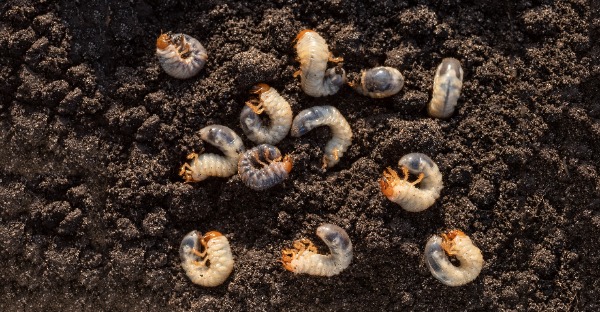Last Updated:
October 17, 2025
Lawn problems in Arizona are often blamed on heat, drought, or hard soil, but there’s another hidden menace that can quietly turn healthy turf into dry, crumbling patches: lawn grubs. These small, pale larvae live beneath the soil, feeding on grass roots and cutting off the very lifeline of your lawn. In a hot climate where grass is already under pressure from high temperatures, the damage can escalate fast.
Let’s take a closer look at how to identify grub problems, understand what’s really going on beneath the surface, and reclaim your Arizona yard and lawn before things get out of hand!

Lawn grubs are the larval stage of several types of beetles, including June beetles and masked chafers, both common in Arizona. These pests spend their larval period beneath the soil, chewing through grass roots to fuel their growth into adult beetles.
Unlike surface pests like chinch bugs or armyworms, grubs do their damage where you can’t see it. By the time patches of grass start to thin or turn brown, the roots may already be severely weakened. Arizona’s warm temperatures and irrigated lawns create an ideal breeding ground, making prevention and early action especially important in our region.
Identifying Lawn Grubs:

Not all dry or yellow patches are caused by grubs, but certain signs are strong indicators that something is feeding below your lawn. Paying attention to how the grass feels and reacts can help you catch the problem early.

Because Arizona lawns face multiple stressors, visual signs alone aren’t enough to be certain. A few simple checks can help confirm what’s really happening:

Grub control isn’t one-size-fits-all. Arizona’s warm climate and irrigated landscapes require a thoughtful approach that targets both active larvae and potential future generations.
Curative insecticides are formulated to kill grubs that have already hatched and begun feeding. Timing is key, as applications are most effective when grubs are small and active near the surface, which usually occurs late summer through early fall. Severe infestations may need more than one round.
Preventive products target beetle eggs and early-stage larvae before they become a problem. For most Arizona lawns, applying preventive grub control in spring or early summer offers the best protection heading into the hotter months.
Beneficial nematodes and Milky Spore are eco-friendly alternatives that target grubs without harming the lawn. Nematodes actively hunt larvae in moist soil, while Milky Spore builds long-term resistance in lawns where susceptible grub species are present.

Keeping grubs out isn’t just about treating infestations when they happen; it’s about making your lawn less attractive to pests in the first place. Consistent care goes a long way toward prevention.
Grub infestations can sneak up fast, but they don’t have to destroy your lawn. Learning how to read the warning signs, act quickly to eliminate pests, and nurture your turf back to strength can keep your lawn healthy and pest-free even in Arizona’s harsh conditions.
Call a local lawn care company near you to determine if your lawn is dealing with a grub problem. If you are in the Gilbert, AZ, area, call Little John’s Lawns to take care of all your grub control and lawn care needs!